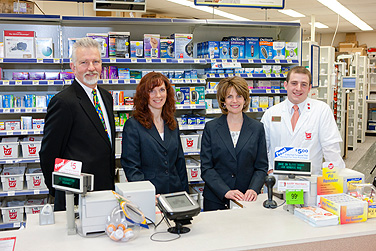News
HIV program educates pharmacists
at Walgreens and around the world

UB has partnered with Walgreens drug stores to educate many of their licensed pharmacists. From left, Edward Bednarczyk, Linda Catanzaro and Marsha Nelson of the UB pharmacy school, and Walgreens’ pharmacist Scott Williamson. Photo: DOUGLAS LEVERE
Imagine having to take as many as 10 to 15 medications a day. Then add to that having to take them exactly on time. And then after following this drug regimen to a tee, you start to feel ill, but not from your disease condition—from one of the medications that treat it.
These are common challenges for individuals with HIV/AIDS, not just in the U.S. but globally. Even with newer formulations and simpler regimens, the drug management of these patients is so knowledge intensive that it has become its own constantly changing subspecialty.
The UB School of Pharmacy and Pharmaceutical Sciences offers three unique HIV continuing-education programs in an online format to help pharmacists all over the world keep their knowledge of HIV pharmacotherapy current.
Thus far, they have provided training to more than 3,800 individual pharmacists from the U.S., Japan, Zimbabwe, Puerto Rico, the Netherlands and Canada.
UB also has partnered with Walgreens drug stores to educate many of their licensed pharmacists in the U.S.
“Our online HIV programs are designed to educate pharmacists on current treatment principles and guidelines for the use of antiretroviral therapy so they can more effectively advise HIV patients and providers in their role as a pharmacist,” says Linda M. Catanzaro, program chair of the UB HIV Pharmacotherapy Continuing Education Center. “We offer them online so that busy pharmacists don’t have to travel and can work at their own pace.”
While the average neighbourhood pharmacist—the one we talk to when we go to the drug store—has to keep up to date on all drugs and their side effects, HIV drug maintenance is especially challenging due to the number of medications, higher risk of adverse drug-drug interactions and complex patient factors, Catanzaro explains.
“There is no typical patient with one set of symptoms; HIV/AIDS manifests itself in many ways and the population is incredibly diverse,” she says.
The patients may range in age from birth to those over 60, may be pregnant or nursing, may be IV-drug users, may have hemophilia, may have hepatitis or pneumonia, may be wealthy or homeless, and may feel healthy or be close to death.
“Therefore, there is no simple approach; each patient’s drug regimen is truly individual,” says Edward M Bednarczyk, chair of the Department of Pharmacy Practice.
“There is a critical link between the patient’s physician and his pharmacist. The patient may see a number of doctors, but often gets all of his drugs in one place, making his pharmacist a key point of contact who can tell if the patient is adhering to the prescribed regimen by how often prescriptions are filled.”
Marsha M. Nelson, the program director, says that because pharmacists work in a variety of settings, such as neighborhood pharmacies, hospitals and clinics that specialize in treating patients with HIV/AIDS, UB has created three distinct training programs. Pharmacists can use their practice setting to determine which program best meets their continuing professional development needs.
“There is an annual update program, which is solely on the Internet and is knowledge-based with a post-test; there is a community-pharmacy, application-based program, which contains active learning components—a combination of home study and live activities; and there is the practice-based program that combines home study and live Internet material, along with an online case submission component,” says Nelson.
Pharmacists from outside the U.S. usually take the practice-based program, she adds.
The programs have pharmacists take a pre-test to assess their baseline knowledge. The average score is 47 out of 100 on the pre-test. After training, the average score on the post-test rises to 82 percent.
“These scores have been consistent,” says Nelson.
Walgreens is the first pharmacy to partner with UB to enroll its pharmacists in the Community CE application-based program and now has them follow up every year in the annual update program. The federal prison system also has selected employees participate in the practice-based program.
UB is accredited by the Accreditation Council for Pharmacy Education (ACPE) and uses ACPE guidelines for continuing education. Currently, there are no across-the-board standards in HIV postgraduate continuing-education programs for pharmacists, but according to Bednarczyk and Catanzaro, UB’s HIV programs are helping to define credentialing for HIV CE and provide the model to meet a range of practice experiences and educational needs.
“Our programs are helping to educate pharmacists here and around the world about the best pharmacy practices in caring for patients with HIV/AIDS,” says Catanzaro.

Reader Comments